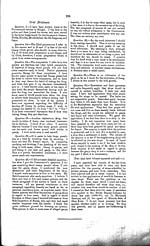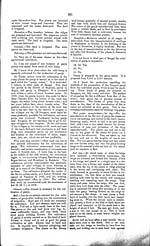Medicine - Drugs > Report of the Indian Hemp Drugs Commission, 1894-1895 > Volume IV
(244) Volume 4, Page 230
Thumbnail gallery: Grid view | List view

230
84. Evidence of
BABU SIR CHUNDER SOOR, Satgope, 1st Assistant Supervisor
of
Ganja Cultivation, Naogaon, Rajshahi.
1. My past services
as clerk and surveyor in
the late ganja inquiry of 1876 under Special
Deputy Collector, Babu Hem Chunder Kerr,
whom I attended at the several inquiries and
different experiments made by him for ascertain-
ment of the various items of information men-
tioned in his report, and my present service as
Assistant Supervisor of ganja cultivation, ex-
tending over a period of about fifteen years, have
afforded me opportunities of obtaining informa-
tion regarding the matter connected with the
hemp drug (ganja), and with the help of this
information I frame the following answers.
2. The definitions
given by Dr. Prain may be
accepted for Bengal. Bhang is locally called
bhang, siddhi or patti. Charas is called charas.
But it is not prepared in the ganja mahal. The
resinous matter that sticks to the hands and feet
of the persons at the time of reaping the plants
and manufacturing them into ganja is not col-
lected but washed away, the quantity being so
small that it seems hardly worth collecting. Dr.
Prain, whom I attended at his experiments,
made an attempt towards this direction, but in
vain.
Ganja.—There are
four varieties of ganja,
and they are known at Naogaon by the
following different names:—
(1) Mota-dal,
or flat large twig
ganja.
(2) Mehi-dal,
or flat small twig
ganja.
(3) Jessori, noray,
gol, or round
ganja.
(4) Chur,
phatak, or broken bits
of ganja, whether
obtained
from the flat or the round
sort.
(4a) Rora, or broken bits
of round
ganja only.
3. I know hemp
plants grow spontaneously in
the districts of Hughli, 24-Parganas, Rajshahi,
Bogra, and Dinajpur. I think they are abundant
in Rajshahi. They grow around the dwelling
houses, in waste lands around the villages, and in
and about the spot where ganja chatars (manu-
facturing yards) are held. They grow to the
height of about six to eight feet.
4. It is known by
the names of bhang, siddhi
or patti. These refer exactly to the same plant.
5. I believe no
special conditions of climate,
soil, rainfall, elevation above the sea level, etc.,
are necessary to the growth of the wild hemp. It
may grow all over Bengal. It grows all the year
round. It dies soon after flowering or as soon as
seeds have ripened.
6. The growth of
the wild hemp plants is ordi-
narily dense.
7. (a) Yes.
(b) No.
(c) No.
(d) No.
The cultivation of ganja is carried on in a small
tract of land called the ganja mahal. It com-
prises parts of the thanas Naogaon in
Rajshahi,
Mahadevpur in Dinajpur, and Adamdighee and
Nawabganj in Bogra. It is included within a
radius of about fourteen miles. The cultivation is
carried on in some 200 villages scattered all over the
tract. The area cultivated in each year is 2,500
big has on an average.
8. There was not any considerable increase or
decrease in area under ganja cultivation in any of
the years since 1879-80 to 1892-93, except in the
years 1884-85 and 1891-92. In 1884-85 the
cultivation decreased. The decrease was due to
the fall in the selling price of ganja in the pre-
vious year, which discouraged many to grow
ganja. In 1891-92 it increased. The increase
was due to the rise of the price of ganja; the high
flood of 1890-91 destroyed the crop, and the price
rose very high, which induced old cultivators to
cultivate more lands, and tempted many non-
ganja cultivators to betake to its
cultivation.
9. The particulars regarding the method of the
cultivajion of ganja are minutely described in
Babu Hem Chunder Kerr's report. I am not able
to give a more minute description of it. No
change in the mode of cultivation has taken place
since the publication of the report. The culti-
vation extends over twelve months, from February
to February, taking the selection of the field in
February as an initial process, to the reaping of
the crop in February as the final process. In
paragraphs 38 to 53 of Hem Babu's report the
description of the cultivation is given. I submit
herewith a brief chronicle of ganja
cultivation.
The cultivation of ganja extends over twelve
months from February to February.
February.—The land for the next crop is select-
ed. It is dressed with fresh earth taken out
from the surrounding ditches or from some near-
est low lands.
March.—The land is ploughed up some four to
six times at an interval of four or five days, to
free it of all herbage and
stubble.
April.—The same.
May.—The same. Sods from the sides of the
field are cut along with the grass and weeds and
thrown on it. The edges of it are then bound
anew with fresh earth taken from the side
ditches.
June.—The land is ploughed thoroughly and
harrowed with ladder. Shallow channels for free
discharge of rain water are made with the plough-
share.
July.—The land is manured with cow-dung and
house-sweepings preserved throughout the year.
It is repeatedly ploughed and harrowed. Shallow
channels are excavated for free drainage of rain
water. The seed bed is ploughed and
harrowed.
August.—The same. Seeds are sown broadcast.
September.—The ridges are formed to trans-
plant seedlings on. The seedlings are gathered
and transplanted.
October.—The field is weeded out of grass.
November.—The ridges are cut down. The
roots of the plants opened, and powdered oilcake
and cow-dung strewn round the roots of the plants.
The openings at the roots closed up with fresh
earth mixed with manure, and the ridges built
again, beaten hard with a piece of bamboo
to
Set display mode to: Large image | Zoom image | Transcription
Images and transcriptions on this page, including medium image downloads, may be used under the Creative Commons Attribution 4.0 International Licence unless otherwise stated. ![]()
| India Papers > Medicine - Drugs > Report of the Indian Hemp Drugs Commission, 1894-1895 > Volume IV > (244) Volume 4, Page 230 |
|---|
| Permanent URL | https://digital.nls.uk/74552738 |
|---|---|
| Description | Evidence of Bengal witnesses. |
| Description | Volume 4: Evidence of witnesses from Bengal and Assam. |
|---|---|
| Attribution and copyright: |
|




